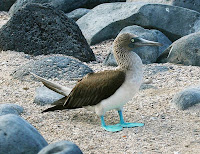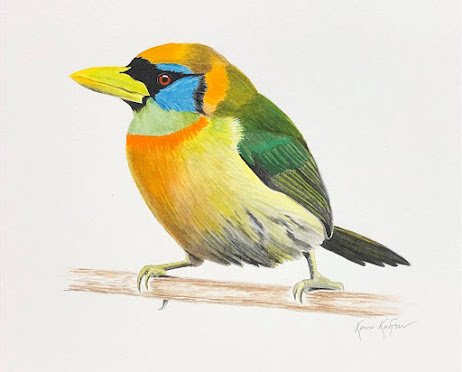Galapagos memories
From somewhere out in cyberspace, Kenn writes: Just looking at the calendar (and at the falling thermometer) and realizing that a year ago today, we were on the Equator, in the Galapagos Islands. I was one of the leaders on a tour organized by Victor Emanuel Nature Tours. Although I'd been there before, this was Kim's first visit to those famous and enchanted islands.

The bird on the Galapagos that everyone has heard about is the Blue-footed Booby. And, admittedly, it's hard to ignore. Sailors in centuries past called these birds "boobies" because they seemed too dumb to be afraid of humans. Actually, they (like the other birds on the Galapagos) evolved in a setting where there weren't any large predators on land, so they have no natural instinct to fear us. What they do have is really impressive blue feet.
 Birders who come here are interested to see the Blue-footed Boobies, of course, but we also want to see everything else, and there are a lot of other specialties of this archipelago. The Swallow-tailed Gulls are spectacular in their own way -- long-winged, long-tailed gulls, sharply patterned in black, white, and gray. The weird thing about them is that they're active mainly at night. Gulls elsewhere in the world may be active at night sometimes (like, foraging in the garbage dump at night if there are lots of lights on) but the Swallow-tailed Gull is mostly nocturnal by choice. Several times when our boat was going from one island to another at night, we would see these gulls flying around over the open ocean, passing through the ship's lights and disappearing into the darkness.
Birders who come here are interested to see the Blue-footed Boobies, of course, but we also want to see everything else, and there are a lot of other specialties of this archipelago. The Swallow-tailed Gulls are spectacular in their own way -- long-winged, long-tailed gulls, sharply patterned in black, white, and gray. The weird thing about them is that they're active mainly at night. Gulls elsewhere in the world may be active at night sometimes (like, foraging in the garbage dump at night if there are lots of lights on) but the Swallow-tailed Gull is mostly nocturnal by choice. Several times when our boat was going from one island to another at night, we would see these gulls flying around over the open ocean, passing through the ship's lights and disappearing into the darkness.

The mockers on the Galapagos may not look so interesting but they're very significant from the standpoint of history. People talk about Charles Darwin coming to the Galapagos and being impressed by the diversity of the finches there -- the group is even referred to as "Darwin's Finches" -- but in fact, Darwin didn't think much of these scuzzy little birds. They all looked about the same to him, so he tossed all his specimens in a box and didn't even bother to label which islands they'd come from. But Darwin did notice that the mockingbirds looked different on the different islands, and that set him to thinking about this idea of evolution.
That picture above is of the form of Galapagos Mockingbird that lives on Santa Cruz Island. We took the picture with a regular lens, not even a telephoto. The birds and other wildlife here are absurdly tame. Sometimes we had to back up away from some bird to get a sharp focus or even to get the whole bird in the frame! The candid photo below shows Kim hard at work photographing Galapagos Sea Lions on the beach on Espanola Island ... a lot of our wildlife photography here required a similar level of effort.


The bird on the Galapagos that everyone has heard about is the Blue-footed Booby. And, admittedly, it's hard to ignore. Sailors in centuries past called these birds "boobies" because they seemed too dumb to be afraid of humans. Actually, they (like the other birds on the Galapagos) evolved in a setting where there weren't any large predators on land, so they have no natural instinct to fear us. What they do have is really impressive blue feet.
 Birders who come here are interested to see the Blue-footed Boobies, of course, but we also want to see everything else, and there are a lot of other specialties of this archipelago. The Swallow-tailed Gulls are spectacular in their own way -- long-winged, long-tailed gulls, sharply patterned in black, white, and gray. The weird thing about them is that they're active mainly at night. Gulls elsewhere in the world may be active at night sometimes (like, foraging in the garbage dump at night if there are lots of lights on) but the Swallow-tailed Gull is mostly nocturnal by choice. Several times when our boat was going from one island to another at night, we would see these gulls flying around over the open ocean, passing through the ship's lights and disappearing into the darkness.
Birders who come here are interested to see the Blue-footed Boobies, of course, but we also want to see everything else, and there are a lot of other specialties of this archipelago. The Swallow-tailed Gulls are spectacular in their own way -- long-winged, long-tailed gulls, sharply patterned in black, white, and gray. The weird thing about them is that they're active mainly at night. Gulls elsewhere in the world may be active at night sometimes (like, foraging in the garbage dump at night if there are lots of lights on) but the Swallow-tailed Gull is mostly nocturnal by choice. Several times when our boat was going from one island to another at night, we would see these gulls flying around over the open ocean, passing through the ship's lights and disappearing into the darkness.
The mockers on the Galapagos may not look so interesting but they're very significant from the standpoint of history. People talk about Charles Darwin coming to the Galapagos and being impressed by the diversity of the finches there -- the group is even referred to as "Darwin's Finches" -- but in fact, Darwin didn't think much of these scuzzy little birds. They all looked about the same to him, so he tossed all his specimens in a box and didn't even bother to label which islands they'd come from. But Darwin did notice that the mockingbirds looked different on the different islands, and that set him to thinking about this idea of evolution.
That picture above is of the form of Galapagos Mockingbird that lives on Santa Cruz Island. We took the picture with a regular lens, not even a telephoto. The birds and other wildlife here are absurdly tame. Sometimes we had to back up away from some bird to get a sharp focus or even to get the whole bird in the frame! The candid photo below shows Kim hard at work photographing Galapagos Sea Lions on the beach on Espanola Island ... a lot of our wildlife photography here required a similar level of effort.




Comments
Post a Comment